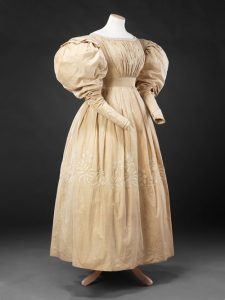Victorian Fashion

It is almost impossible to sum up fashion in the Victorian era as the timespan is so great. Just like the twentieth century it is easier to see it in terms of decades. Think how different 1950’s fashion is from that of the 1960’s and the same is true of the 1850’s and the 1860’s, but I think the clearest way to watch its evolution, in women’s fashion anyway, is to see it as the era of the changing silhouette. Corsetry dominates and is the foundation upon which everything is quite literally hung. After the relative freedom of the Regency era, women are once again imprisoned in yards of fabric and restrictive boning.
I think it is true to say too that these changes are prompted by Victoria herself. The country has a young, pretty new queen and the way she dressed is bound to have had an influence on her subjects, similar to the ‘Kate Middleton’ effect today. Theresa Meyers, interesting writer on all things steampunk, takes this theory even further:
In 1837, Victoria ascends to the throne. She’s young, only 18, and beautiful and the silhouette of the time reflects that ingénue-like frame. Times are changing, there’s research happening about dinosaurs in the Pleistocene epoch, Samuel Morse has exhibited his electric telegraph at the College of the City in New York, and there’s a Gag Law in place passed by the U.S. Congress suppressing the debate on slavery.
By 1842, Victoria would have been, 23, and trying to appear very grown up. The skirts are widening (as are the hips and bust line after bearing two children), and do so even more in 1847 when she would have already had five children.
In 1852, at the age of 33, Victoria is truly on her way to showing the world that the English are a world power. They control India, Tasmania, Australia, parts of Canada. Notice the amount (and expense) of ruffles and added lace in the silhouettes of both 1852 and 1857.
However by 1862 the silhouette changes drastically to more simple lines. Victoria’s beloved husband Albert died in December 1861. As Victoria grows older and more critical of the behaviour of her wild son Prince Edward, you can almost see the stricture and behavioural mores of the Victorian era changing in 1867 as the skirts grow increasingly more tight and confining until 1882.
Know what surprised me most? Check out the difference between the first image 1837 and the third to last image of 1892. Not much difference is there? Ever hear how at the end we start thinking about the beginning. Makes me wonder if the same was happening with Queen Victoria. Or perhaps, like all fashion, they just started recycling things, and she just happened to be old enough for what was old to become new again.
Notice that by 1902 the silhouette has become so relaxed there’s barely even a bustline anymore. It looks almost worn out and tired. Since Victoria died in 1901, I can see why. (Well that and Edward, who succeeded her, did tend to be a pretty relaxed sort of guy.)

For in depth information I highly recommend visiting the Victoria and Albert Museum website’s pages on Victorian fashion from 1840 to 1890 as there is a wealth of information on both men’s and women’s changing styles and photographs of extant garments from their own extensive collections.
When designing my own costume I chose the year 1897, the year of Queen Victoria’s Diamond Jubilee. For those of you who like ‘fun facts’ this is also the year that Bram Stoker published Dracula, Enid Blyton was born, Victoria sees the first moving pictures of herself in a film shot at Windsor Castle, and the first drunk driver was arrested. The reason I chose it though is because, being at the latter end of the century, it allows me to play most of the music in the Victorian period authentically. It also allows me to sit down at the piano easily, although on first wearing I swept a whole tray of wine glasses onto the floor with my ‘leg of mutton’ sleeves!






